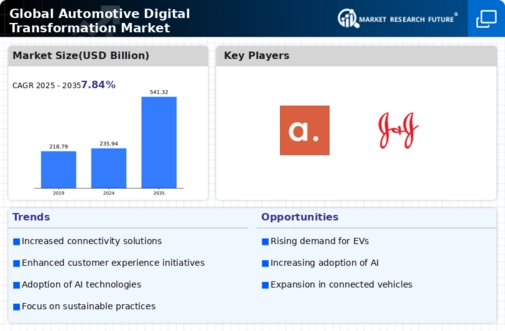Leading players in the automotive digital transformation market are focusing on innovation and strategic partnerships to stay competitive. They invest in research and market developments to develop advanced digital technologies, such as connected car solutions, autonomous driving systems, and predictive analytics. Additionally, they form collaborations with technology firms, automotive manufacturers, and startups to leverage expertise and expand their product offerings. Moreover, leading players prioritize customer-centric approaches, offering tailored solutions to meet evolving consumer demands and regulatory requirements, ensuring their market leadership.
Manufacturing locally to minimize operational costs is one of the key business tactics used by manufacturers in the global Digital Transformation industry to benefit clients and increase the market sector. In recent years, the industry has offered some of the most significant advantages to OEMs. Major players in the Digital Transformation market, including Bosch, Continental AG, Aptiv PLC, NVIDIA Corporation, Qualcomm Technologies, Inc., Intel Corporation, TomTom N.V., Harman International Industries, Incorporated, Panasonic Corporation, Microsoft Corporation, and Others, are attempting to increase market demand by investing in research and development operations.
Continental AG is a leading provider of automotive technology, offering a wide range of solutions in the market. With a focus on innovation and sustainability, Continental develops advanced technologies such as autonomous driving systems, vehicle connectivity solutions, and digital cockpit platforms. The company leverages its expertise in sensors, software, and electronics to deliver integrated solutions that enhance vehicle safety, efficiency, and comfort. Additionally, Continental collaborates with automakers and industry partners to drive innovation and shape the future of mobility.
With a global presence and a commitment to driving technological advancements, Continental AG continues to be a trusted partner for automotive manufacturers worldwide in navigating the digital transformation of the automotive industry.
Microsoft Corporation, a global leader in technology, plays a significant role in the market. Leveraging its cloud computing platform Azure, Microsoft provides innovative solutions for connected vehicles, autonomous driving, and mobility services. Azure enables automakers to develop and deploy advanced analytics, AI-driven insights, and IoT solutions, transforming vehicles into intelligent, data-driven platforms. Microsoft's partnerships with automotive manufacturers and industry stakeholders facilitate the integration of digital technologies into vehicles, enhancing safety, efficiency, and user experience. Moreover, Microsoft's expertise in cybersecurity ensures robust protection for connected vehicles against cyber threats.
With its commitment to innovation and collaboration, Microsoft continues to drive the digital transformation of the automotive industry, shaping the future of mobility.













Leave a Comment